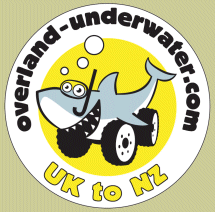| Final Statistics: Alex & Maz | Total distance: 93,550km |
| Furthest Point: Rotorua, NZ | Now settled in Sydney, Australia |
| Final Statistics: Martin | Total distance: 79,698km |
| Furthest Point: Hobart, Australia | Now settled in Bristol, UK |
Thai (water) fighters
Thailand, Country 19, Diary entry 11th-22nd April 2006, Total distance in Thailand (first pass): 4226km
The Good News We have now passed the half-way point in our fundraising target! We would like to thank everyone who has donated so far. We think the second half will be harder than the first half though so please dig deep and help us achieve our goal!
The Bad News Alex and Maz�s laptop has blown up and much of the work they do is while on the move so their diary entries will be a bit thin on the ground until they get it fixed (hopefully in Bangkok). For the same reason please be patient if you�re waiting for email from them!
After our narrow escape from the clutches of the passport officials on the Lao side of the border, we crossed the so-called Friendship Bridge across the Mekong River and into country number 19 of the trip, Thailand.
I had been looking forward to Thailand because it is one of those countries where you never meet people who have been but disliked it, and of course then there is the food. It had been high on my list of places to go for many years but I'd never quite made it before. So the first thing we did on entering the country was go to Tesco's!
Actually we already knew there was one in the first town across the border because in Vientiane we'd seen Tesco Value products in the guesthouse, in the restaurants - just small stuff like pens and pads of paper, plastic cups and that sort of thing. But the idea of going to Tesco's very much appealed to us for stocking up on more good cheese and whatever, like we'd enjoyed doing so much at Carrefour in Kunming, China.
It's immediately apparent on crossing the border how much more advanced Thailand is compared to its neighbour to the north (and presumably the other neighbours in the region too) - the Tesco complex was a proper shopping mall, the car park had security guards and a ticket system. In Laos there aren't enough cars to warrant such a thing. The supermarket was very similar to what you'd see in Europe and we stocked up with enough goodies to see us through the next few days and I even managed to find, for the first time since leaving Europe, fresh semi-skimmed milk! My cup of PG Tips (teabags carried from England) that evening was good enough that I imagined I could be in England, but on the whole I found myself imagining I was in the USA as I was driving along perfect smooth roads, dead straight because the land is so flat, and even the colours of the road surface, the markings on the road, the yellow and black road signs, the 7-11 shops everywhere reminded me of the States. The only difference was that we were back on the proper side of the road again having gone through a Scalextric-style changeover from right to left as we left Laos and drove onto the Friendship Bridge.
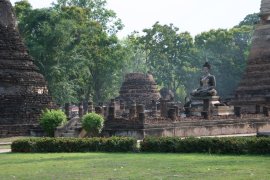 Another thing we were prepared for before entering Thailand was the fact that it was just coming up to Songkran, which is the Thai New Year festival. It is a water festival, meaning I'm not sure what in ancient times but nowadays basically what happens is that everyone has a big water fight. As we drove along the road there were kids at the sides of the roads with water pistols squirting our car as we drove past. Not much of a problem for us in our sealed air-conditioned capsules but in Thailand many people have open backed pickup trucks and passengers ride in the back, but even worse the poor motorcyclists were prime targets and many of the kids decided that water pistols were not enough and took to throwing buckets of water over each motorcyclist that went past!
Another thing we were prepared for before entering Thailand was the fact that it was just coming up to Songkran, which is the Thai New Year festival. It is a water festival, meaning I'm not sure what in ancient times but nowadays basically what happens is that everyone has a big water fight. As we drove along the road there were kids at the sides of the roads with water pistols squirting our car as we drove past. Not much of a problem for us in our sealed air-conditioned capsules but in Thailand many people have open backed pickup trucks and passengers ride in the back, but even worse the poor motorcyclists were prime targets and many of the kids decided that water pistols were not enough and took to throwing buckets of water over each motorcyclist that went past!
Our first sight to visit in Thailand was Sukhothai, which is the original capital of the first Thai kingdom and today has ruins of nearly 100 temples (mostly classic Buddhist lotus-bud shaped stupas), moats and other structures dating back from these times. As we drove through the town there was a huge traffic jam caused by a throng of people at the side of the road engaging in battle with the people on pickup trucks. Each pickup had a large drum of water mounted on the back so that the people riding along would have a steady supply of ammo to fire off at the pedestrians, who were also very well armed. It was very entertaining to watch! Finally we got through the gauntlet with our cars very wet, and in some places covered in a gloopy mess of flour and water where some people had decided that plain water just wasn't enough, and we parked up away from the action, while the locals parked up in the centre of things and continued their water fighting whilst having a few Chang beers to go with it (nasty stuff). Max and I decided to each go off on our own and we hired bikes, Alex and Maz walked. I discovered that a farang (Westerner) on a bike was just too good a target for the partying Thais and I got drenched from head to foot by gangs of them. It was refreshing though!
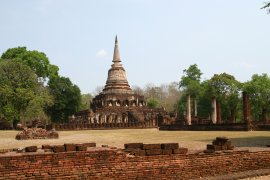 Max had finally decided what his plans were (he had to return to England for some work commitments) so we camped not far up the road and the next morning we took him to the local bus station for him to catch a bus to Bangkok, from where he'd fly out the next day. My passenger seat is now empty, though not for much of Thailand and Malaysia where I have another few special guests lined up, after which Max should return to join us as we travel through the islands of Indonesia and to the top end of Australia.
Max had finally decided what his plans were (he had to return to England for some work commitments) so we camped not far up the road and the next morning we took him to the local bus station for him to catch a bus to Bangkok, from where he'd fly out the next day. My passenger seat is now empty, though not for much of Thailand and Malaysia where I have another few special guests lined up, after which Max should return to join us as we travel through the islands of Indonesia and to the top end of Australia.
We'd woken up quite early because of the heat (the tents are like greenhouses by 7am), so Max was in plenty of time for his bus and I made it further north to the site of Si Satchanalai by mid-morning.
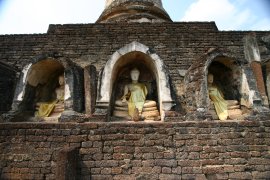 Si Satchanalai is now part of the same World Heritage site as Sukhothai although it's about 50km away, and is pretty much "more of the same". There are several temples dating from the 13th-15th centuries in various states of disrepair and I found it to be nicer than Sukhothai partly because it was more tucked away in the woods giving it a more remote feel, but mainly I think simply because there were less people there and those there were there to see the place and not just to party. After an hour though the party people started turning up, so I made a break for it and continued further north to Chiang Mai.
Si Satchanalai is now part of the same World Heritage site as Sukhothai although it's about 50km away, and is pretty much "more of the same". There are several temples dating from the 13th-15th centuries in various states of disrepair and I found it to be nicer than Sukhothai partly because it was more tucked away in the woods giving it a more remote feel, but mainly I think simply because there were less people there and those there were there to see the place and not just to party. After an hour though the party people started turning up, so I made a break for it and continued further north to Chiang Mai.
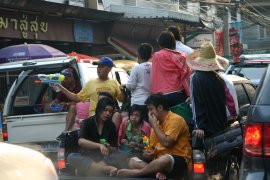 The Songkran festival goes on for several days and there were still a couple to go. It took me about 2 hours from arriving in Chiang Mai until reaching the centre because of the water fights going on around me, so eventually I decided to abandon all plans to "see" Chiang Mai and instead parked the car, put on clothes I didn't mind getting wet, put my money in a plastic bag and braved the crowds. I gave the curious pleasure of being the first to soak me to some little kid near where I parked but within minutes I'd been targeted so many times that it didn't make much difference any more. One thing that wasn't obvious from inside the car was that many of the large drums of water also contained huge blocks of ice, so the water those people were throwing was freezing! I took shelter in one of the bars along the main street and watched the proceedings whilst being soggy.
The Songkran festival goes on for several days and there were still a couple to go. It took me about 2 hours from arriving in Chiang Mai until reaching the centre because of the water fights going on around me, so eventually I decided to abandon all plans to "see" Chiang Mai and instead parked the car, put on clothes I didn't mind getting wet, put my money in a plastic bag and braved the crowds. I gave the curious pleasure of being the first to soak me to some little kid near where I parked but within minutes I'd been targeted so many times that it didn't make much difference any more. One thing that wasn't obvious from inside the car was that many of the large drums of water also contained huge blocks of ice, so the water those people were throwing was freezing! I took shelter in one of the bars along the main street and watched the proceedings whilst being soggy.
I found a hotel with a large courtyard and checked in to a room, and as the festivities were dying down just after sunset I took a walk around the town. There is a market area in the central square where there were various assorted food hawkers and I had my favourite - Pad Thai - while watching the soaked people milling around.
The next day, well it was obvious what was going to happen so I went out with good intentions of exploring the town, and I did visit a couple of the more impressive temples, but I left my camera at home because there was no way it was going to survive. Sure enough the water fight started again and I wasn't going to be beaten this time... I bought a water pistol, a one-shot type made out of a bit of water pipe and a plunger. Chiang Mai has a large moat forming a square around the city centre so as I was walking round exploring the tow I was never far from a refilling station for my water pistol! There were many Westerners getting stuck in but the vast majority were Thais so again they decided I was a great target and made me feel right at home with a bucket of water in the face, time and time again. I'd like to think I gave as good as I got but I was massively outnumbered. I fought bravely though.
In the evening the fighting died down once more and I visited the night market, which is basically a load of stalls set up along the streets in a particular part of the city, selling anything and everything that a tourist might possibly want... fake designer clothing, DVDs and all sorts of souvenirs. There were some fixed shops as well, some of them having some incredibly detailed wood carvings which I pored over for quite a while, but then when it came to leave and look at the outdoor stalls again - the heavens had opened!! It was absolutely bucketing it down and the stallholders were scurrying around rigging up all sorts of tarpaulins to make roofs, with varying levels of success. I mooched around the dry bits for a while waiting for a lull in the weather but it never came. I walked back to the hotel using the cover of awnings or overhangs from the buildings, but to no avail, the dry clothes I'd put on only an hour beforehand were soaked through, my money had gone all soggy as I'd thrown away the plastic bag, and I got home looking like a drowned rat and much more miserable than earlier in the day when I'd meant it to happen.
I gave up on seeing the real Chiang Mai and left to head south to the small border town of Mae Sot from where I managed to clock a bonus country...
Myanmar (Burma), Country 20, Diary Entry 11:10am-2:30pm 17th April 2006, Total distance in Myanmar: about 8km (on foot)
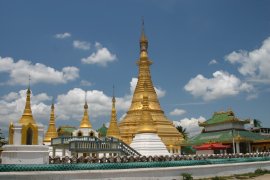 To cross from Thailand to Myanmar here is very simple - it involves leaving Thailand, walking across yet another Friendship Bridge (my third!) and entering Myanmar. No visa is needed in advance to enter Myanmar at this border crossing, but it is also not permitted for foreigners to go any further into Myanmar than this one border town, called Myawaddy. To ensure this rule is adhered to, they kept my passport at the passport control and gave me a receipt. I am never comfortable leaving my passport with anyone but I didn't have much choice and I'd hope the passport control people should take good care of it.
To cross from Thailand to Myanmar here is very simple - it involves leaving Thailand, walking across yet another Friendship Bridge (my third!) and entering Myanmar. No visa is needed in advance to enter Myanmar at this border crossing, but it is also not permitted for foreigners to go any further into Myanmar than this one border town, called Myawaddy. To ensure this rule is adhered to, they kept my passport at the passport control and gave me a receipt. I am never comfortable leaving my passport with anyone but I didn't have much choice and I'd hope the passport control people should take good care of it.
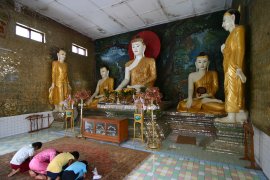 On crossing the border it was again striking how different things are - coming from Thailand with the brand new pickup trucks everywhere to Myanmar with very few motorised vehicles at all, just a few scooters but mostly bicycles. The shops are like shacks on the side of the dusty and broken road, and the people are surprised to see foreign faces again. Only the temples were stunning - very ornately decorated on the outside with huge golden stupas, and giant porcelain or gold plated Buddhas inside, one of them even encrusted with precious and semi-precious stones. We've seen in many countries now that religion has a way of taking the wealth from the people but the opulence of this temple in the middle of a poor little border town was a contrast enough to make me place it second only to the Potala Palace in Tibet.
On crossing the border it was again striking how different things are - coming from Thailand with the brand new pickup trucks everywhere to Myanmar with very few motorised vehicles at all, just a few scooters but mostly bicycles. The shops are like shacks on the side of the dusty and broken road, and the people are surprised to see foreign faces again. Only the temples were stunning - very ornately decorated on the outside with huge golden stupas, and giant porcelain or gold plated Buddhas inside, one of them even encrusted with precious and semi-precious stones. We've seen in many countries now that religion has a way of taking the wealth from the people but the opulence of this temple in the middle of a poor little border town was a contrast enough to make me place it second only to the Potala Palace in Tibet.
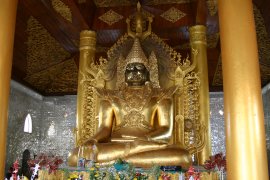 I wandered round the town and didn't really find much else, so trying to find something to extend my time in the country to more than a couple of hours I sat down at one restaurant for a coffee followed 20 minutes later by lunch at another (another noodle-based dish, nothing much to write home about) then eventually I had to resign myself to the fact that there was nothing more to do, I bought a couple of Myanmar beers to take with me just to try it, and crossed back over the bridge to Thailand.
I wandered round the town and didn't really find much else, so trying to find something to extend my time in the country to more than a couple of hours I sat down at one restaurant for a coffee followed 20 minutes later by lunch at another (another noodle-based dish, nothing much to write home about) then eventually I had to resign myself to the fact that there was nothing more to do, I bought a couple of Myanmar beers to take with me just to try it, and crossed back over the bridge to Thailand.
 It gave me a small taste for the country and a desire to see more, but not on this trip. One for the list in the future.
It gave me a small taste for the country and a desire to see more, but not on this trip. One for the list in the future.
Though the roads in Thailand are fantastic compared to any other country we'd been through since leaving Iran, or maybe even earlier, there are still some large distances to cover and it took me the rest of that day plus most of the next to get to Kanchanaburi.
Kanchanaburi is perhaps not a very well known name but the anglicized version of the river's name is very famous indeed. This is where the Bridge Over the River Kwai is situated.
In 1942-43 the Japanese army was advancing across Southeast Asia, and finding the need for an overland supply route to their troops attempting to conquer Myanmar they enlisted the use of the prisoners of war from the campaigns in their conquests of Malaya, Java and Singapore to build a railway linking Myanmar to Bangkok. Much of the railway was built in difficult terrain that required deep cuttings and high bridges, and despite Japanese engineers estimating it would take 5 years to build the railway (it was Japanese engineers who designed the railway, not the Allies as portrayed in the film), the Japanese army forced the POWs to complete the 415km track in a mere 16 months. As a result of the dangerous work, the extreme heat and humidity and tropical diseases, 16,000 of the POWs died during the construction.
 I started my visit to the town at the Thailand-Burma Railway Centre, which is a museum explaining the history of the railway in an interesting and educational way. There are many models of the railway and the terrain which give a good impression of the problems and hardships they faced during construction, and many personal items from the POWs.
I started my visit to the town at the Thailand-Burma Railway Centre, which is a museum explaining the history of the railway in an interesting and educational way. There are many models of the railway and the terrain which give a good impression of the problems and hardships they faced during construction, and many personal items from the POWs.
Walking out of the museum you are faced with the larger of two war cemeteries containing the graves of Allied POWs. The Japanese were reasonably good at keeping records of the POWs (and in the case where they lapsed the POWs themselves kept records too) so the vast majority of the graves are marked. As we experienced in Gallipoli, the sight of row upon row of graves, each with a plaque showing a name, age and personal epitaph is a very sobering experience. The Commonwealth War Graves Commission tends this cemetery with the great care it deserves and I spent well over an hour walking among the graves and reading the memorials.
 The following day I took a leisurely stroll along the main street towards the bridge itself. It was a lot further than it looked on the map, and along the way I met two other people who were also stupid enough to make the walk in the heat of midday - Jaclyn, a Scot now living in San Francisco, and Rachel, an American pretending to be a Canadian.
The following day I took a leisurely stroll along the main street towards the bridge itself. It was a lot further than it looked on the map, and along the way I met two other people who were also stupid enough to make the walk in the heat of midday - Jaclyn, a Scot now living in San Francisco, and Rachel, an American pretending to be a Canadian.
We all expected it to be just a bridge. We were going there because that's what you're supposed to do, but when we got there we all thought the same: the bridge is very imposing and it makes a very fitting monument to the men who built it. We took our time walking between the tracks across the bridge and back, keeping one eye over our shoulders for the little tourist train that shuttles the lazier tourists over.
After such a long exposure to the sun we decided that there was one last angle we ought to take a photo from: a floating restaurant moored on the river right next to the bridge. Jaclyn had a veg tempura (or whatever they call it in Thai), Rachel a papaya salad, and nice guy that I am, I helped them out when the servings were too large for them.
We discussed our plans and it turned out we all wanted to see Hellfire Pass so we decided we would go together the next day.
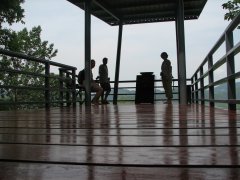 During the construction of the Death Railway, a number of cuttings had to be made through the rock and Hellfire Pass was the name given to the most difficult of these cuttings by the POWs themselves, because when they were working at night the illumination of the candles made the cutting look like the entrance to hell. Of the mostly Australian POWs who were brought to work here, a staggering 70% of them died. The railway was ripped up by the Thais after the war but this cutting has been preserved with some of the original rails and sleepers as a memorial to those who died.
During the construction of the Death Railway, a number of cuttings had to be made through the rock and Hellfire Pass was the name given to the most difficult of these cuttings by the POWs themselves, because when they were working at night the illumination of the candles made the cutting look like the entrance to hell. Of the mostly Australian POWs who were brought to work here, a staggering 70% of them died. The railway was ripped up by the Thais after the war but this cutting has been preserved with some of the original rails and sleepers as a memorial to those who died.
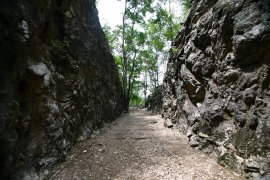 The oppressive heat of the place made it difficult just walking from the visitor's centre to the cutting itself, so how the men managed to do hard labour in these conditions I don't know, and once inside the cutting, rather than being shaded the rock seemed to trap the heat. Having the place to ourselves for most of the time made the experience quite sombre.
The oppressive heat of the place made it difficult just walking from the visitor's centre to the cutting itself, so how the men managed to do hard labour in these conditions I don't know, and once inside the cutting, rather than being shaded the rock seemed to trap the heat. Having the place to ourselves for most of the time made the experience quite sombre.
Our plan was to cover both Hellfire Pass and the Erawan Falls in the one morning before returning to Kanchanaburi for Rachel to catch her train to Bangkok, but we found ourselves running a little late after dedicating the time to Hellfire Pass that it deserved. It looked like we'd only have an hour at the falls but decided to go anyway - after the heat of the morning we were all looking forward to a swim to cool off.
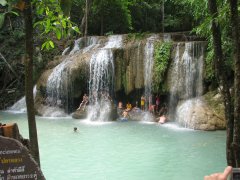 Erawan National Park is Thailand's most visited national park and popular with Thais and visitors alike, and the highlight is a 7-tiered waterfall. Our visit was a really brief one in the end; by the time we'd got through the small roads and villages to the park entrance, and from there to the car park we only had about three quarters of an hour before we'd have to leave, so walking quickly to the bottom of the falls, and then up to tier 2 we had time for a mere 20 minute swim. I managed the full 20 minutes in the water, Rachel was not far behind but Jaclyn was complaining about the fish biting her legs as she tried to get in so she took a little longer but we all managed long enough to cool down properly, and though we all wanted to stay longer and explore the upper levels of the falls, our time was up and we had to leave. Haring back to town with Rachel in the back seat making up ham and cheese sandwiches as fast as we could eat them (yes it is true, after Max's departure and a good tidy-up I can now fit a person in the back seat!) we found the way back to be a better road than the way out and arrived at the train station in Kanchanaburi with a good 15 minutes to spare. Dammit, we could have nearly doubled our time at the falls, but oh well.
Erawan National Park is Thailand's most visited national park and popular with Thais and visitors alike, and the highlight is a 7-tiered waterfall. Our visit was a really brief one in the end; by the time we'd got through the small roads and villages to the park entrance, and from there to the car park we only had about three quarters of an hour before we'd have to leave, so walking quickly to the bottom of the falls, and then up to tier 2 we had time for a mere 20 minute swim. I managed the full 20 minutes in the water, Rachel was not far behind but Jaclyn was complaining about the fish biting her legs as she tried to get in so she took a little longer but we all managed long enough to cool down properly, and though we all wanted to stay longer and explore the upper levels of the falls, our time was up and we had to leave. Haring back to town with Rachel in the back seat making up ham and cheese sandwiches as fast as we could eat them (yes it is true, after Max's departure and a good tidy-up I can now fit a person in the back seat!) we found the way back to be a better road than the way out and arrived at the train station in Kanchanaburi with a good 15 minutes to spare. Dammit, we could have nearly doubled our time at the falls, but oh well.
Farewell to the ladies, for I was then on my way south for the long journey to Phuket where Alex had arranged some diving for us, just in time for the end of the season...
Thanks to Rachel for a couple of the photos.
| All content copyright � overland-underwater.com - please do not use without permission. |
| Comment from Scooter |
| Hi Martin, I did the Myawaddy trip in 1988 - doesn't sound like its changed much ;0) Cheers Martin |
| 18 May 2006 @ 22:17:24 |
